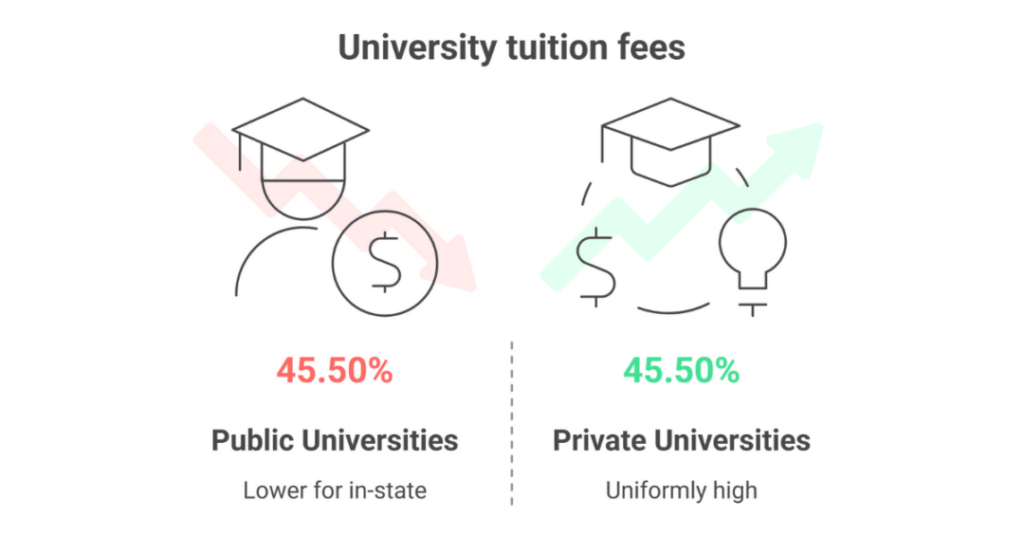30 May 2025
6 minutes read
Key Difference Between Public and Private Universities in USA: Tips for Indian Students

Key Takeaways
- Difference between public and private universities in USA is mainly about funding, tuition, and governance.
- Difference between public and private universities in USA affects cost, campus size, and class experience.
- Difference between public and private universities in USA helps students choose based on goals and budget.
While selecting the ideal college for pursuing higher studies in the US, most students from India tend to get plagued by one major juncture: public or private?
The difference between private and public universities in the US is not merely in terms of cost, but also on the size of the university, the sources of funding, student diversity, and even campus life.
While public universities are subsidized by the public through state governments, private universities are funded by private donations, tuition charges, and other private sources.
This article deconstructs major differences between public and private universities in the USA, making it easier for Indian students to comprehend the difference.
By analyzing both major and smaller private and public universities in-depth, you can select a university in the USA suitable for your academic aspirations, budget, and needs. Let’s untangle what’s the difference and which university can be the best for you.
What are Public Universities in the US?
Fun fact: The University of California system alone educates over 280,000 students each year!
Public universities are funded by the public, meaning they receive significant financial support from state governments.

These public institutions offer a wide range of programs and are generally larger in size and student population. Public universities in the USA are an essential part of higher education in the US.
- Public universities are funded by state governments and are referred to as public institutions.
- Public universities tend to have lower tuition fees for in-state residents.
- Public colleges typically have large campuses and thousands of students enrolled.
- Public universities offer a wider range of majors than many private colleges.
- Public universities attract a diverse population, including a large number of international students.
- Public universities might provide more research opportunities due to larger budgets and facilities.
- Public universities are usually more accessible to residents of the state.
- Public universities receive government funding regularly, which helps keep tuition lower.
What are Private Universities in the US?
Fun fact: Ivy League universities, such as Harvard and Yale, are all private institutions!
Private universities in the USA do not receive state funding. These private universities and colleges rely on private donations, tuition fees, and endowments for their operation. A private university or college often emphasizes smaller class sizes and a more focused academic experience.
- Private universities are funded by private sources such as alumni donations and tuition fees.
- Private unis might have smaller class sizes and better student-to-faculty ratios.
- Many private colleges are liberal arts colleges with a strong focus on undergraduate education.
- Private universities tend to offer generous financial aid packages, including merit-based scholarships.
- Private universities also include prestigious private research universities and Ivy League institutions.
- Private universities might provide more personalized academic advising.
- Private universities receive funding from private donors, which enhances campus facilities.
- Private colleges simply have more flexibility in curriculum design and special programs.
Public vs Private Universities in the US: Key Differences
Fun fact: Although private universities make up only about 20% of colleges, they enroll nearly 30% of all international students in the US!
Understanding the difference between public and private universities is crucial when choosing a university in the USA. These colleges and universities vary in cost, academic offerings, campus environment, and more.
To understand the difference better, review the following table that highlights the key points of difference between both institutions:
| Feature | Public Universities | Private Universities | Relevance and Importance |
|---|---|---|---|
| Funding Source | Government funding | Pvt sources | Determines tuition cost and facility quality |
| Tuition Fees | Lower for in-state; higher for out-of-state | Uniformly high | Impacts affordability for Indian and international aspirants |
| Campus Size | Generally larger | Often smaller | Affects student experience and class size |
| Student Diversity | Very diverse | Varies, but often diverse | Important for cultural exchange and global exposure |
| Academic Programs | Offer a wider range of majors | May offer specialized programs | Impacts academic fit and career goals |
| Faculty Access | Less personalized | More personalized | Affects mentorship and academic support |
| Research Opportunities | Significant in large public universities | High in private research universities | Important for students aiming for graduate studies |
| Prestige | Includes top state universities | Includes Ivy League and elite institutions | Influences future career opportunities |
| Source of Revenue | Funded by the public | Funded by pvt donations and tuition | Impacts resource availability |
| International Services | Public universities also provide dedicated support for international students | Private unis tend to have robust international student support | Helps with cultural adaptation |
Public or Private Universities: Which one is the Best For You?
Fun fact: Some private universities have endowments larger than the GDP of small countries!
Choosing the right college depends on your academic needs, financial situation, and personal preferences. Whether to attend a public or private university in the USA also depends on your long-term goals.

Understanding the main difference between public and pvt institutions is vital in making the right choice.
| Criteria | Best Fit: Public University | Best Fit: Pvt University | Reason |
| Budget | Yes, especially for lower tuition | No, unless strong financial aid is provided | Cost-effectiveness matters |
| Personalized Attention | Not always guaranteed | Often better due to smaller size | Helps in academic performance |
| Campus Life | Vibrant with many student organizations | Intimate and community-driven | Varies by personality |
| Prestige | Some top public universities are world-renowned | Ivy League and other elite schools | Impacts resume and network |
| Class Size | Large lectures common | Smaller, more focused classes | Impacts learning style |
| Flexibility in Majors | Wide range of options | May be more specialized | Influences career pathways |
| International Student Services | Often well-established | High-touch support in elite schools | Essential for smooth transition |
| Public vs Private | Public colleges offer a wider range of affordable programs | Private colleges offer exclusive networks and branding | Decision depends on career and financial goals |
| Public/ Private Universities | Public universities are generally larger and more affordable | Pvt unis tend to provide personalized learning | Choose based on lifestyle preference |
| Higher Education in the US | Public and private colleges both contribute significantly | Universities offer varied experiences | Evaluate which college experience fits you |
Top Public and Private Universities in USA for Indian Students
Fun fact: The University of Illinois Urbana-Champaign has more Indian students than any other US university!
Choosing the right university in the USA is not just about academics but also about the campus environment, support services, and networking opportunities.
Many students from India are searching for universities that cater to international aspirants’ needs. Below are the best options across public and private universities in the US:
Top 5 Public Universities in the USA:
| University | Location | Known For |
| University of California, Berkeley | California | Engineering, Business, and Sciences |
| University of Michigan, Ann Arbor | Michigan | Research, Engineering, Public Health |
| University of Illinois Urbana-Champaign | Illinois | Computer Science and Engineering |
| University of Texas at Austin | Texas | Business, Computer Science |
| Georgia Institute of Technology | Georgia | Engineering and Technology |
Top 5 Private Universities in the USA:
| University | Location | Known For |
| Massachusetts Institute of Technology (MIT) | Massachusetts | Technology, Engineering, Innovation |
| Stanford University | California | Business, Computer Science, Entrepreneurship |
| Harvard University | Massachusetts | Law, Business, Medicine |
| Princeton University | New Jersey | Liberal Arts, Mathematics, Research |
| University of Southern California (USC) | California | Media, Arts, Engineering |
These universities receive significant donations and are known for their strong financial support for students. Meanwhile, public universities are funded by state governments and usually offer better affordability.
Conclusion
It is essential to know the difference between public and pvt universities in the USA for Indian students to select the appropriate college for higher education. Public unis tend to be less expensive, bigger, and provide a great range of majors.
Private colleges, however, can provide smaller classes, individualized attention, and excellent financial aid deals. Regardless of whether you attend a public college or university or a private college or university, ensure that it fits your career aspirations and affordability level.
Ensure you look at test requirements such as IELTS, TOEFL, GRE, SAT, GMAT, and prepare solid documents such as a resume, letter of recommendation, personal statement, and statement of purpose.
Selecting a US university is a major choice, and understanding the major differences between pvt and public colleges makes the decision simpler and wiser.
Weigh all public and private colleges wisely as you seek your college journey in the US higher education system with Ambitio, your trusted abroad study partner!
FAQs
What is the main difference between public and private universities in USA?
The main difference between public and private universities in USA lies in their funding sources—public universities receive government funding, while private universities rely on private donations and tuition.
How does the difference between public and private universities in USA affect tuition fees?
The difference between public and private universities in USA significantly impacts tuition fees; public universities usually offer lower tuition for in-state students, while private universities tend to have higher tuition for all students.
Does the difference between public and private universities in USA influence class sizes?
Yes, the difference between public and private universities in USA influences class sizes—public universities often have larger classes, whereas private universities tend to offer smaller, more personalized classes.
Are research opportunities affected by the difference between public and private universities in USA?
Research opportunities are abundant in both, but the difference between public and private universities in USA means public institutions may have broader programs, while private universities often focus on specialized research.
What should international students know about the difference between public and private universities in USA?
International students should understand that the difference between public and private universities in USA affects costs, scholarships, and admission requirements, helping them choose the right university.
How does the difference between public and private universities in USA impact campus life?
The difference between public and private universities in USA affects campus size and culture—public universities are usually larger and diverse, while private universities offer a close-knit community.
Why is it important to understand the difference between public and private universities in USA before applying?
Understanding the difference between public and private universities in USA is vital because it guides students on funding, class sizes, and program options, ensuring they pick the right college for higher education.

You can study at top universities worldwide!
Get expert tips and tricks to get into top universities with a free expert session.
Book Your Free 30-Minute Session Now! Book a call now




























